Unit - 3
Solution of First and Second order Networks
Series RLC circuit:

R i(t) + L d i(t)/dt + 1/C  dx = vs(t)
dx = vs(t)
d 2 i(t) / dt 2 + R/L d i(t)/dt + 1/LC i(t) = 1/L d vs(t) /dt
Most circuits with one inductor and capacitor are not easy to analyse hence every voltage and current in the circuit is the solution to the differential equation given by

The roots of the characteristic equation whether the complementary solution wiggles.


If ς > 1 , s1 and s2 are real and not equal then

The solution is overdamped.
If ς < 1, s1 and s2 are complex then



The solution is underdamped.
If ς = 1, s1 and s2 are real and equal

The solution is critically damped.
Parallel RLC circuit

The left diagram shows an input with initial inductor current Io and capacitor voltage Vo. The top-right diagram shows the input current source I N set equal to zero. The bottom-right diagram shows the initial conditions Io and Vo set equal to zero which lets you obtain the zero state response.
Using KCL we get
iN(t) =iR(t) +iC(t) +iL(t)
The resistor current iR(t) is based on the old, reliable Ohm’s law:
i R(t) = v(t)/R
The element constraint for an inductor is given as
v(t) = L di(t) /dt
The current iL(t) is the inductor current, and L is the inductance. This constraint means a changing current generates an inductor voltage. If the inductor current doesn’t change, there’s no inductor voltage, implying a short circuit.
Parallel devices have the same voltage v(t).The inductor voltage v(t) equal to the capacitor voltage to obtain capacitor current iC(t):
Ic(t) = C dv(t)/dt = LC d2 iL(t)/dt 2
Now substitute v(t) = L diL(t)/dt into Ohm’s law, because same voltage appears across the resistor and inductor:
i R (t) = (L/R) d i L(t) /dt
Substitute the values of iR(t) and iC(t) into the KCL equation to get currents in terms of the inductor current:
i N (t) = LC d 2 i L (t) / dt 2 + (L/R) d iL(t)/dt + i L(t)
The RLC parallel circuit is described by a second-order differential equation, so the circuit is a second-order circuit.
The unknown is the inductor current iL(t).
v T(t) = LC d 2 vc(t)/ dt2 + RC dvc(t)/dt + vc (t)
For a parallel circuit the second-order and homogeneous differential equation is given in terms of the inductor current:
0 = d 2 iL /dt 2 + (1/RC) d iL(t)/dt + (1/LC) iL(t)
k 2 + 1/RC k + !?LC =0 -- k1,k2 = - 1/2RC  ½
½  [ (1/RC) 2 – 4/LC]
[ (1/RC) 2 – 4/LC]
The preceding equation gives you three possible cases under the radical:
Case 1: [ (1/RC) 2 – 4/LC ] >0 two different roots α 1 and α 2.
Case 2: [(1/RC) 2 – 4/LC] =0 two equal roots (α1=α2)
Case 3: [1/RC) 2 – 4/LC] <0 two complex conjugate roots (α1  j β)
j β)
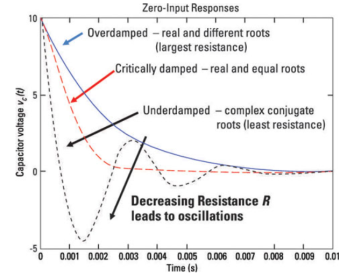
When k1 and k2 are known, we obtain the zero-input response iZI(t). The solution gives you

To find the constants c1 and c2 by using the results found in the RLC series circuit, which are given as
c 1 = k2 Vo – Io/C / k2 – k1
c2 = -k1 Vo + Io/C / k2 -k1
Apply duality to the preceding equation by replacing the voltage, current, and inductance with their duals (current, voltage, and capacitance) to get c1 and c2 for the RLC parallel circuit:
c 1 = k2 Io – Vo/L / k2 -k1
c2 = -k1Io + Vo/L / k2 -k1
For RC circuit
Ic = 0A when t< to
Vc = 0V when t < to
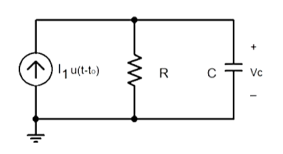
Because I1 =0A (replace it with open circuit)
Find the final condition of the voltage across the capacitor
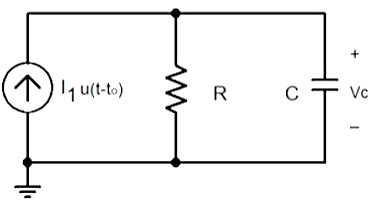
Ic =0A when ͂ ∞ s
Vc = VR = I1R when ~ ∞ s
RL circuit:
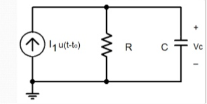
In the time between to and t=∞ s, the capacitor stores energy and currents flow through R and C.
Vc = VR
Ic = C dVc/dt
IR = VR/R
IR + Ic -I1 =0
Vc/R + C dVc/dt – I1 =0
Vc (t) = R I1 [ 1 – e – t-to/ τ] τ=RC
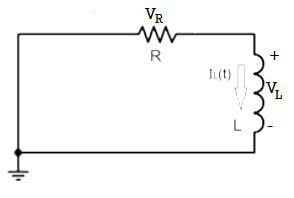
Initial condition is not important as the magnitude of the voltage source in the circuit is equal to 0V when t≤ to.
Since the voltage source has only been turned on at t=to the circuit at t ≤ to is shown below:
As the inductor has not stored any energy because no power source has been connected to the circuit all voltages and currents are equal to zero.

So, the final condition of the inductor current needs to be calculated after the voltage source has switched on.
Replace L with a short circuit and calculate IL (∞)
Final condition:
VL(∞) = 0V
I L (∞) = IR
I R = V1 /R
RL circuit
-V1 + VL + VR =0
I L = I R = V R /R
VL = L dIL/dt
DIL/dt + R I R -V1 =0
DIL/dt + R/L IL – V1/L =0
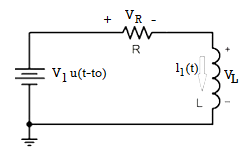

Consider the following example:
The equation of motion of the body mass is
m. d 2 x/ dt 2 + c . Dx /dt + k.x = F -------------------------(1)
Where:
m [kg] – mass
k [N/m] – spring constant (stiffness)
c [N⋅s/m] – damping coefficient
F [N] – external force acting on the body
x [m] – displacement of the body
The free response of a system is the solution of the describing differential equation of the system, when the input is zero.
In our case the input into the system is the force F [N]. Therefore, in order to verify the free response of the system we have to solve the differential equation:
M . d 2 x / d t2 + c. Dx /dt + k.x =0 -----------------------------(2)
To be able to see the free response, we need an initial condition. For our example we are going to set the initial conditions:
x(0)=0.4
v(0)=0
The free response of the mass spring-damper system will be the variation in time of the displacement x [m].
To integrate equation (2),write it in the following form:
d 2 x/ dt2 = 1/m . ( -c dx/dt – k.x)
Equation (3) is modelled and integrated in Xcos

The general equation of a free response system has the differential equation in the form:
 d i x / d t i = 0 -----------------------------(4)
d i x / d t i = 0 -----------------------------(4)
Forced response of a system
The forced response of a system is the solution of the differential equation describing the system, taking the impact of the input. If the input is force F [N] then
m . d 2 x / d t 2 + c . Dx /dt + k.x = F(t)
To visualise the forced system response of a system, all the initial conditions must be zero:
x(0)=0
v(0)=0
The forced response of the mass spring-damper system will be the variation in time of the displacement x [m].
d 2 x / d t2 = 1/m . (F-c . dx/dt – k.x )
We can reuse the Xcos model from the free system response, the only differences being that there is an input step force added and the initial condition of the position is 0 m.
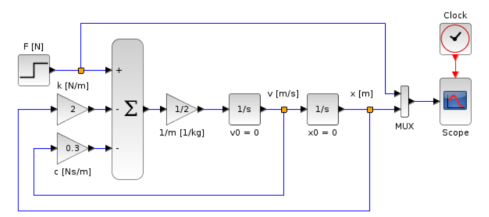

Let us assume, the capacitor is initially unchanged, and the switch S is closed at time t = 0. After closing the switch, electric current i(t) starts flowing through the circuit. Applying Kirchhoff Voltage Law in that single mesh circuit, we get,
v = R i(t) + 1/C  dt
dt
Differentiating both sides with respect to time t, we get
R d i(t) /dt + i(t) /C =0
R di(t)/dt = - i(t)/C
-RC d i(t)/i(t) = dt
d i(t)/ i(t) = -1/R C dt
Integrating both side we get,
 = -1/RC dt
= -1/RC dt
Log e i(t) + log e i(k) = -t/RC
Now, at t = 0, the capacitor behaves as short circuit, so, just after closing the switch, the current through the circuit will be,
Io = V/R
Now, putting this value in equation (i) we get,
k V/R = e 0
k = R/V
Putting the value of k at equation (i) we get,
I(t) = V/R e -t/RC
Now, if we put t = RC in the final expression of circuit current i(t), we get,
I t=RC = V/R e-1
= 0.367 V/R = 0.367 Io or 36.7 % of Io
From the above mathematical expression it is clear that RC is the time in second during which the current in a charging capacitor diminishes to 36.7 percent from its initial value. Initial value means, current at the time of switching on the unchanged capacitor.
This term is quite significant in analyzing behaviour of capacitive as well as inductive circuit. This term is known as time constant.
So, time constant is the duration in seconds during which the current through a capacities circuit becomes 36.7 percent of its initial value. This is numerically equal to the product of resistance and capacitance value of the circuit. Time constant is normally denoted by τ (tau). So,
Τ = RC
In complex RC circuit, time constant will be product of equivalent resistance and capacitance of circuit.
If we plot current i(t).
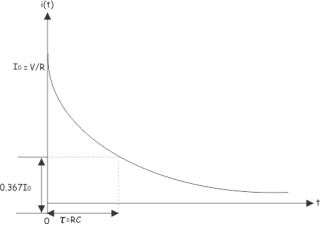
At t = 0, the current through the capacitor circuit is
Io = V/R
At t = RC, the current through the capacitor is
0.367 Io = 0.367 V/R
Example:
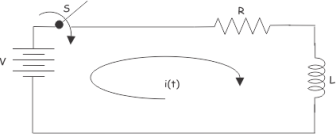
Applying KVL in the above circuit. We get,
V = R i(t) + L d i(t)/dt
The equation can also be solved using Laplace transform technique. For that we have to take Laplace transform of the equation at both sides,
V/s = L [ s I(s) – i(0+) ] + R I(s)
V/s = L s I(s) + R I(s)
I(s) = V / s(Ls + R)
Hence, in this equation.
I(0+) =0
Since, current just after switch is on, current through the inductor will be zero.
Now,
I(s) = No / Ls (s + R/L) = Vo/L . 1/ s(s + R/L)
Taking inverse Laplace of the above equation, we get,
i(t) = No/R [ 1 – e -Rt/L]
Now, if we put,
t = L/R
We get,
i(L/R) = Vo/R [ 1- e-1 ] = 0.633 Vo/R
So, at RL circuit, at time = L/R sec the current becomes 63.3% of its final steady state value. The L/R is known as time constant of an RL circuit. Let us plot the current of inductor circuit.

The time constant of an RL circuit is the ratio of inductance to resistance of the circuit.
References:
1. Mahmood Nahvi, Joseph A Edminister, “Schaum’s outline of Electric Circuits”, 6th Edition, Tata McGraw-Hill, 6th Edition, 2013
2. W. H. Hayt and J. E. Kemmerly, “Engineering Circuit Analysis”, McGraw Hill Education, 2013.
3. C. K. Alexander and M. N. O. Sadiku, “Electric Circuits”, McGraw Hill Education, 2004.
4. K. V. V. Murthy and M. S. Kamath, “Basic Circuit Analysis”, Jaico Publishers, 1999.
5. K. Sureshkumar, “Electric Circuits & Network”, Pearson Publication
6. Del Toro, “Electrical circuit”, Prentice Hall